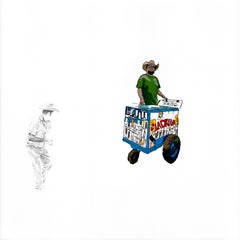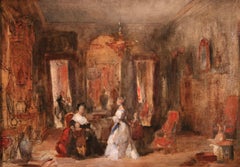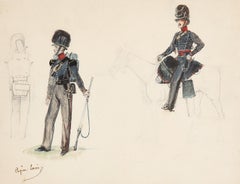Eugene Louis Lami Art
French, 1800-1890
Eugène Louis Lami (12 January 1800 – 19 December 1890) was a French painter, watercolorist, lithographer, illustrator and designer. He was a painter of fashionable Paris during the period of the July Monarchy and the Second French Empire and also made history paintings and illustrations for books such as Gil Blas and Manon Lescaut. He worked at the studio of Horace Vernet then studied at the École des Beaux-Arts in Paris with Camille Roqueplan and Paul Delaroche under Antoine-Jean Gros. While there, he learned watercolor technique from Richard Parkes Bonington and later became a founding member of the Society of French Watercolorists.
Lami began working in lithography and in 1819 produced a set of 40 lithographs depicting the Spanish cavalry. These, plus a collaboration with Vernet on a large set of lithographs titled Collections des uniformes des armées françaises de 1791 à 1814 helped build a reputation for doing military scenes which transferred to his paintings. His 1829 portrait of the English king, Charles I of England as he was being led to imprisonment in Carisbrooke Castle was purchased by King Louis-Philippe of France and was on display in the French National Assembly from 1848 to 1969.
Today, this work along with his 1840 painting of Louise Marie Adélaïde de Bourbon-Penthièvre, duchesse d'Orléans in the gardens of the Tuileries Palace are both in the Louvre. Lami's painting of the Battle of New Orleans, depicting the moment of the American victory over the British on 26 January 1815 is in the Louisiana State Museum at The Cabildo in New Orleans. He also painted a scene of the storming of Redoubt during the Siege of Yorktown.(Biography provided by Fremiot)
to
1
1
1
1
Overall Height
to
Overall Width
to
1
1
1
1
1
1
6,847
3,168
2,517
1,217
1
1
Artist: Eugene Louis Lami
Orientalist Watercolor Painting a Carpet Merchant by Eugene Louis Lami
By Eugène Louis Lami
Located in New York, NY
The Carpet Seller depicts a man in a domed Fez hat as he is approached by three women and a child. Middle eastern architecture floods the scene. The way the pa...
Category
19th Century Eugene Louis Lami Art
Materials
Watercolor
Related Items
The Abduction of the Sabine Women , a Renaissance drawing by Biagio Pupini
Located in PARIS, FR
This vigorous drawing has long been attributed to Polidoro da Caravaggio: The Abduction of the Sabine Women is one of the scenes that Polidoro depicted between 1525 and 1527 on the façade of the Milesi Palazzo in Rome. However, the proximity to another drawing inspired by this same façade, kept at the Ecole des Beaux-Arts, and to other drawings inspired by Polidoro kept at the Musée du Louvre, leads us to propose an attribution to Biagio Pupini, a Bolognese artist whose life remains barely known, despite the abundant number of drawings attributed to him.
1. Biagio Pupini, a Bolognese artist in the light of the Roman Renaissance
The early life of Biagio Pupini, an important figure of the first half of the Cinquecento in Bologna - Vasari mentions him several times - is still poorly known. Neither his date of birth (probably around 1490-1495) nor his training are known. He is said to have been a pupil of Francesco Francia (1450 - 1517) and his name appears for the first time in 1511 in a contract with the painter Bagnacavallo (c. 1484 - 1542) for the frescoes of a church in Faenza. He then collaborated with Girolamo da Carpi, at San Michele in Bosco and at the villa of Belriguardo.
He must have gone to Rome for the first time with Bagnacavallo between 1511 and 1519. There he discovered the art of Raphael, with whom he might have worked, and that of Polidoro da Caravaggio. This first visit, and those that followed, were the occasion for an intense study of ancient and modern art, as illustrated by his abundant graphic production.
Polidoro da Caravaggio had a particular influence on the technique adopted by Pupini. Executed on coloured paper, his drawings generally combine pen, brown ink and wash with abundant highlights of white gouache, as in the drawing presented here.
2. The Abduction of the Sabine Women
Our drawing is an adaptation of a fresco painted between 1525 and 1527 by Polidoro da Caravaggio on the façade of the Milesi Palace in Rome. These painted façades were very famous from the moment they were painted and inspired many artists during their stay in Rome. These frescoes are now very deteriorated and difficult to see, as the palace is in a rather narrow street.
The episode of the abduction of the Sabine women (which appears in the centre of the photo above) is a historical theme that goes back to the origins of Rome and is recounted both by Titus Livius (Ab Urbe condita I,13), by Ovid (Fasti III, 199-228) and by Plutarch (II, Romulus 14-19). After killing his twin brother Romus, Romulus populates the city of Rome by opening it up to refugees and brigands and finds himself with an excess of men. Because of their reputation, none of the inhabitants of the neighbouring cities want to give them their daughters in marriage. The Romans then decide to invite their Sabine neighbours to a great feast during which they slaughter the Sabines and kidnap their daughters.
The engraving made by Giovanni Battista Gallestruzzi (1618 - 1677) around 1656-1658 gives us a good understanding of the Polidoro fresco, allowing us to see how Biagio Pupini reworked the scene to extract this dynamic group.
With a remarkable economy of means, Biagio Pupini takes over the left-hand side of the fresco and depicts in a very dense space two main groups, each consisting of a Roman and a Sabine, completed by a group of three soldiers in the background (which seems to differ quite significantly from Polidoro's composition).
The balance of the drawing is based on a very strongly structured composition. The drawing is organised around a median vertical axis, which runs along both the elbow of the kidnapped Sabine on the left and the foot of her captor, and the two main diagonals, reinforced by four secondary diagonals. This diamond-shaped structure creates an extremely dynamic space, in which centripetal movements (the legs of the Sabine on the right, the arm of the soldier on the back at the top right) and centrifugal movements (the arm of the kidnapper on the left and the legs of the Sabine he is carrying away, the arm of the Sabine on the right) oppose each other, giving the drawing the appearance of a whirlpool around a central point of support situated slightly to the left of the navel of the kidnapper on the right.
3. Polidoro da Caravaggio, and the decorations of Roman palaces
Polidoro da Caravaggio was a paradoxical artist who entered Raphael's (1483 - 1520) workshop at a very young age, when he oversaw the Lodges in the Vatican. Most of his Roman work, which was the peak of his career, has disappeared, as he specialised in facade painting, and yet these paintings, which are eminently visible in urban spaces, have influenced generations of artists who copied them abundantly during their visits to Rome.
Polidoro Caldara was born in Caravaggio around 1495-1500 (the birthplace of Michelangelo Merisi, known as Caravaggio, who was born there in 1571), some forty kilometres east of Milan. According to Vasari, he arrived as a mason on the Vatican's construction site and joined Raphael's workshop around 1517 (at the age of eighteen according to Vasari). This integration would have allowed Polidoro to work not only on the frescoes of the Lodges, but also on some of the frescoes of the Chambers, as well as on the flat of Cardinal Bibiena in the Vatican.
After Raphael's death in 1520, Polidoro worked first with Perin del Vaga before joining forces with Maturino of Florence (1490 - 1528), whom he had also known in Raphael's workshop. Together they specialised in the painting of palace façades. They were to produce some forty façades decorated with grisaille paintings imitating antique bas-reliefs.
The Sack of Rome in 1527, during which his friend Maturino was killed, led Polidoro to flee first to Naples (where he had already stayed in 1523), then to Messina. It was while he was preparing his return to the peninsula that he was murdered by one of his assistants, Tonno Calabrese, in 1543.
In his Vite, Vasari celebrated Polidoro as the greatest façade decorator of his time, noting that "there is no flat, palace, garden or villa in Rome that does not contain a work by Polidoro". Polidoro's facade decorations, most of which have disappeared as they were displayed in the open air, constitute the most important lost chapter of Roman art of the Cinquecento. The few surviving drawings of the painter can, however, give an idea of the original appearance of his murals and show that he was an artist of remarkable and highly original genius.
4. The façade of the Milesi Palace
Giovanni Antonio Milesi, who commissioned this palace, located not far from the Tiber, north of Piazza Navona, was a native of the Bergamo area, like Polidoro, with whom he maintained close friendly ties. Executed in the last years before the Sack of Rome, around 1526-1527, the decoration of Palazzo Milesi is considered Polidoro's greatest decorative success.
An engraving by Ernesto Maccari made at the end of the nineteenth century allows us to understand the general balance of this façade, which was still well preserved at the time. The frescoes were not entirely monochrome, but alternated elements in chiaroscuro simulating marble bas-reliefs and those in ochre simulating bronze and gold vases...
Category
16th Century Old Masters Eugene Louis Lami Art
Materials
Ink, Gouache, Pen
"Ladrillo" (FRAMED) Painting 20.5" x 21" inch by Antonio Pelayo
Located in Culver City, CA
"Ladrillo" (FRAMED) Painting 20.5" x 21" inch by Antonio Pelayo
Medium: Pencil on Paper. Acrylic Ink & Paint on Animation Acetate
Image size: 15" x 1...
Category
21st Century and Contemporary Contemporary Eugene Louis Lami Art
Materials
Ink, Acrylic
H 20.5 in W 21 in D 1.5 in
Lobster dinner at the Carlyle, Watercolor social scene New York City
By Manuel Santelices
Located in Miami Beach, FL
Lobster dinner at the Carlyle, by Manuel Santelices
Watercolor and Gouache on paper
Image size: 12 in. H x 9 in. W
Unframed
2023
The worlds of fashion, society, and pop culture are...
Category
21st Century and Contemporary Contemporary Eugene Louis Lami Art
Materials
Watercolor, Gouache, Paper
H 12 in W 9 in D 0.1 in
"Los Huevos" (FRAMED) Painting 21" x 20.5" inch by Antonio Pelayo
Located in Culver City, CA
"Los Huevos" (FRAMED) Painting 21" x 20.5" inch by Antonio Pelayo
Medium: Pencil on Paper. Acrylic Ink & Paint on Animation Acetate
Image size: 15" x...
Category
21st Century and Contemporary Contemporary Eugene Louis Lami Art
Materials
Ink, Acrylic
H 21 in W 20.5 in D 1.5 in
"Las Metas Pequeńas" (FRAMED) Painting 21" x 20.5" inch by Antonio Pelayo
Located in Culver City, CA
"Las Metas Pequeńas" (FRAMED) Painting 21" x 20.5" inch by Antonio Pelayo
Medium: Pencil on Paper. Acrylic Ink & Paint on Animation Acetate
Image size: 15" x 15" inch
Size framed...
Category
21st Century and Contemporary Contemporary Eugene Louis Lami Art
Materials
Ink, Acrylic
H 21 in W 20.5 in D 1.5 in
Coffee Peloton XXXI
By Eliza Southwood
Located in Deddington, GB
Coffee Peloton XXXI by Eliza Southwood [2022]
original
Coffee on Paper
Image size: H:59.5 cm x W:42.5 cm
Complete Size of Unframed Work: H:59.5 cm x ...
Category
21st Century and Contemporary Abstract Impressionist Eugene Louis Lami Art
Materials
Coffee, Paper
Elegant Evening - (15"x23", Dress Painting, Framed)
By Andrea Stajan-Ferkul
Located in Mississauga, Ontario
This dress painting on board blends mediums to create textured detail with an outcome both expressive and refined. A scripted pencil pattern adds to the...
Category
2010s Contemporary Eugene Louis Lami Art
Materials
Acrylic, Pencil, Color Pencil, Board
"Sueńos Chicos" (FRAMED) Painting 21" x 20.5" inch by Antonio Pelayo
Located in Culver City, CA
"Sueńos Chicos" (FRAMED) Painting 21" x 20.5" inch by Antonio Pelayo
Medium: Pencil on Paper. Acrylic Ink & Paint on Animation Acetate
Image size: 15...
Category
21st Century and Contemporary Contemporary Eugene Louis Lami Art
Materials
Ink, Acrylic
Tom Cawson (Sitting - Hand on Head), Mixed media on grey cardboard
By Howard Tangye
Located in London, GB
Howard Tangye (b.1948, Australia) has been an influential force in fashion for decades. Lecturing at London’s Central Saint Martins for 35 years, including 16 years as head of BA Wom...
Category
21st Century and Contemporary Contemporary Eugene Louis Lami Art
Materials
Other Medium, Paint, Graphite, Color Pencil, Carbon Pencil, Pencil, Pen,...
"Lavate Los Dientes" (FRAMED) Painting 21" x 20.5" inch by Antonio Pelayo
Located in Culver City, CA
"Lavate Los Dientes" (FRAMED) Painting 21" x 20.5" inch by Antonio Pelayo
Medium: Pencil on Paper. Acrylic Ink & Paint on Animation Acetate
Image siz...
Category
21st Century and Contemporary Contemporary Eugene Louis Lami Art
Materials
Ink, Acrylic
H 21 in W 20.5 in D 1.5 in
The Dressing Room #4, 5"x7", Artwork On Paper, Leopard Print Dress Painting
By Andrea Stajan-Ferkul
Located in Mississauga, Ontario
This delicate leopard print dress is an artwork on paper blending paint and color pencil. Composition, intuitive mark-making and loose textured detail make for an outcome both expres...
Category
2010s Contemporary Eugene Louis Lami Art
Materials
Paper, Acrylic, Pencil, Color Pencil
Craig (Richard's Friend - Sitting - Blue Jacket), Mixed media on grey parchment
By Howard Tangye
Located in London, GB
Howard Tangye (b.1948, Australia) has been an influential force in fashion for decades. Lecturing at London’s Central Saint Martins for 35 years, including 16 years as head of BA Womenswear. There, he tutored many contemporary greats, including John Galliano, Stella McCartney, Christopher Kane, Wes Gordon, Zac Posen and Hussein Chalayan.
Examples of Tangye’s portraits are held in many important collections, both public and private, including the Victoria and Albert Museum (V&A), Harvard University and London’s National Portrait Gallery.
Throughout his teaching career Tangye quietly developed a particularly idiosyncratic art practice. By employing a decisive line with bold applications of richly layered materials, Tangye explores the nuances of the human form in an effort to expose his subjects’ true essence and energy.
—
Howard Tangye
Craig (Richard's Friend - Sitting - Blue Jacket), 2012
Mixed media on grey...
Category
2010s Contemporary Eugene Louis Lami Art
Materials
Paint, Paper, Parchment Paper, Chalk, Charcoal, Crayon, Oil Crayon, Oil ...
Previously Available Items
A Salon in the House of Baron James Rothschild, Rue Lafitte, Paris - Eugene Lami
By Eugène Louis Lami
Located in Marlow, Buckinghamshire
A beautiful oil on canvas circa 1860 by French academic painter Eugene Louis Lami depicting elegant figures standing in the interior of the house of Baron James Rothschild, the founder of Rothschild Bank.
Dimensions:
Framed: 15.5"x20.5"
Unframed: 11.5"x16.5"
Provenance:
Christies London 17 November 1994 - Lot 122
Eugène Lami studied under Gros, Horace Vernet, and at the École des Beaux-Arts. He exhibited at the Salon from 1824 until 1878. He was awarded a second-class medal in 1875, became a Chevalier of the Légion d'Honneur in 1837 and was made an officer in 1862.
His early work was as a lithographer. He is considered to have possessed the acuity of Raffet, with less force of expression but more elegance. He was the accredited chronicler of the July Monarchy par excellence. He illustrated Queen Victoria's visit to Eu in 1843. He executed decorations, also at Eu, in Renaissance style, and undertook the project to decorate the duke of Nemours' apartment at the Tuileries in the style of Napoleon III.
In the revolution of 1848 he decided to go into exile in England, where he exhibited at the Royal Academy and achieved great success in British high society. On his return to France in 1852 he once more embarked on a brilliant career, becoming the official decorator to Baron James de Rothschild at Ferrières, where he revived the Venetian Rococo style, creating a pastiche of Tiepolo for the Venetian Carnival in the smoking room at the château.
His first lithograph dates from 1817, entitled Harlequin and Scapin Discussing their Family Name, in colour and signed E. He continued to produce small works, which he signed Eugène. The collection of French Army Uniforms from 1791 to 1814 (100 pieces in colour, in collaboration with Horace Vernet, 1822) and the famous collection of French Uniforms...
Category
1860s Academic Eugene Louis Lami Art
Materials
Oil, Canvas
Eugène Lami (1800-1890) Studies of a horseman and soldiers Watercolor
By Eugène Louis Lami
Located in Paris, FR
Eugène Lami (1800-1890)
Studies of a horseman and soldiers
Watercolor, gouache and black pencil on paper
Signed lower left
17.3 x 23 cm
Framed: 32.5 x 39 cm
Eugène Louis Lami w...
Category
1860s Academic Eugene Louis Lami Art
Materials
Watercolor, Gouache
Cavalier
By Eugène Louis Lami
Located in Wiscasset, ME
French painter and lithographer Eugene Louis Lami was born in 1800. Lami studied at the Ecole des Beaux-Arts in Paris with Camille Roqueplan and Paul...
Category
19th Century Realist Eugene Louis Lami Art
Materials
Watercolor
Eugene Louis Lami art for sale on 1stDibs.
Find a wide variety of authentic Eugene Louis Lami art available for sale on 1stDibs. You can also browse by medium to find art by Eugene Louis Lami in paint, watercolor and more. Not every interior allows for large Eugene Louis Lami art, so small editions measuring 19 inches across are available. Customers who are interested in this artist might also find the work of Pierre Ambrogiani, Emil Kosa Jr., and Lucien-Victor Guirand de Scévola. Eugene Louis Lami art prices can differ depending upon medium, time period and other attributes. On 1stDibs, the price for these items starts at $5,500 and tops out at $5,500, while the average work can sell for $5,500.




